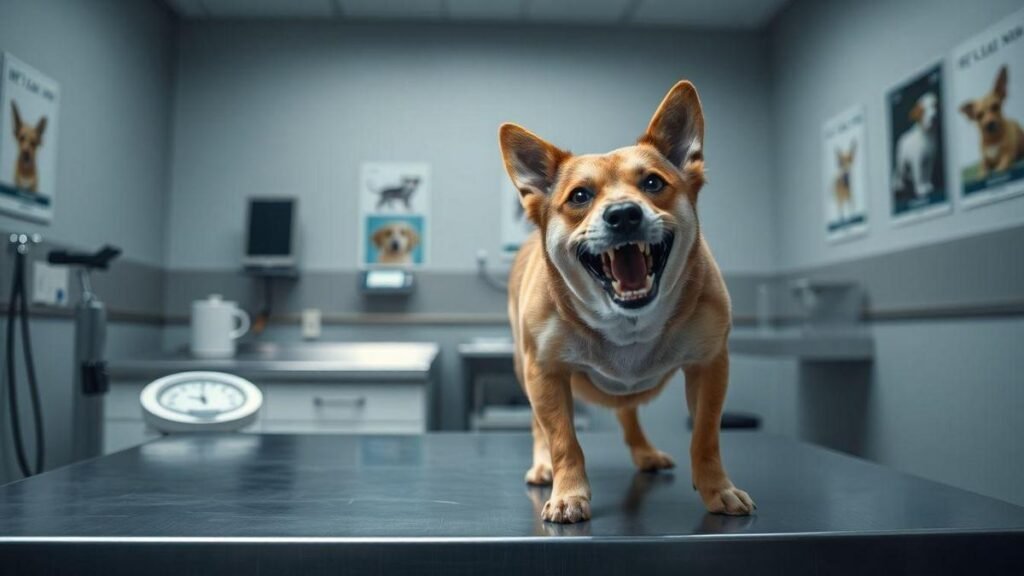Comportamento agressivo em gatos e cães durante visitas ao veterinário
Comportamento agressivo em gatos e cães durante visitas ao veterinário is something I watch for every day. I spot signs fast — growls, lunges, hisses, swipes, a stiff body. Fear and pain often drive this. I check medical causes first, then use low-stress handling, towels, and muzzles when needed. I share simple calming tips and short desensitization steps owners can do at home. I plan appointments to cut triggers and follow clear safety rules if things escalate, because I want you and your pet to feel calmer and safer.
Key takeaway
- Stay calm to help your pet feel safe.
- Bring high-value treats and a familiar toy/blanket.
- Tell the vet about your pet’s triggers and pain history.
- Ask for gentle handling and short breaks.
- Practice short, kind visits to build trust with your pet: simple trust-building steps.
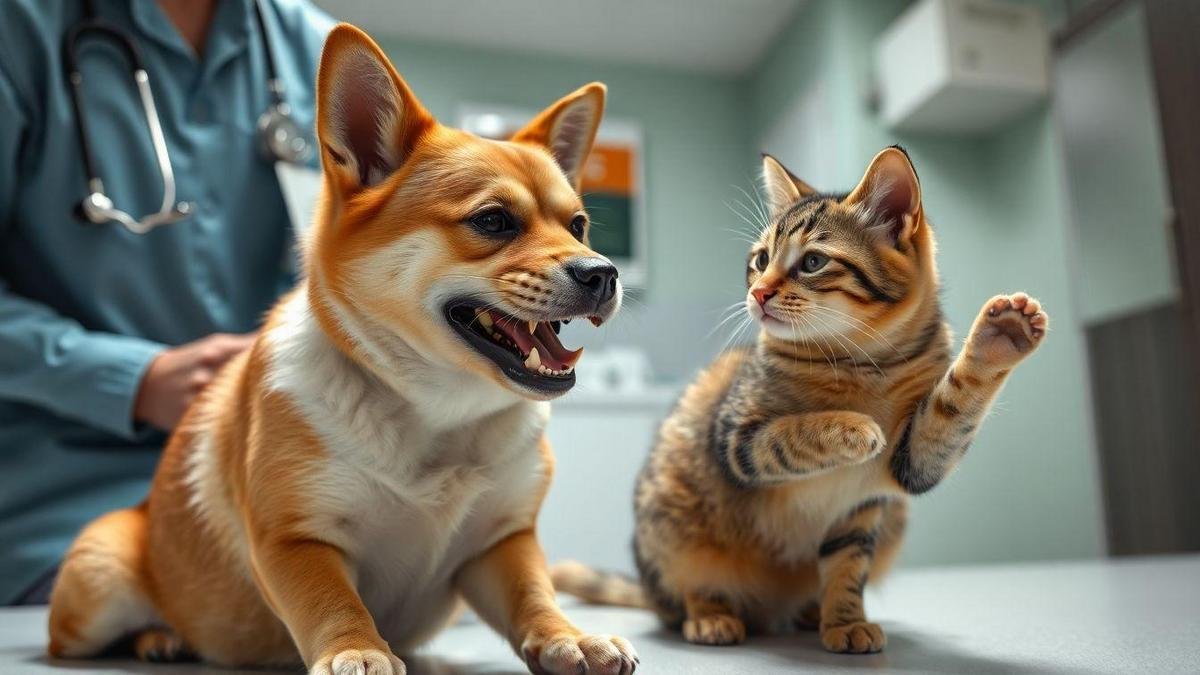
How I spot Comportamento agressivo em gatos e cães durante visitas ao veterinário
Signs in dogs
I watch dogs from the moment they enter. Key signs:
- Growling or low rumbling
- Lunging or sudden forward movement
- Stiff body, raised hackles, fixed stare, tail high/tucked
Example: a shepherd once stiffened and gave a soft growl when a tech reached for a paw — I stepped back, gave space, and the exam continued calmly.
| Sign | What I see | What it often means |
|---|---|---|
| Growling | Low vocal sound | Warning or fear |
| Lunging | Sudden forward move | Trying to reach or scare away |
| Stiff body | Rigid posture | High stress or readiness |
Signs in cats
Cats show stress differently:
- Hissing, spitting
- Swiping with claws out
- Flattened ears, puffed tail, wide eyes
Example: my cat hissed when touched near the neck. I paused, wrapped her gently in a towel, and asked for slower handling.
| Sign | What I see | What it often means |
|---|---|---|
| Hissing | Sharp breath sound | Fear or warning |
| Swiping | Quick paw strike | Defensive reaction |
| Flattened ears | Ears pinned back | Very scared or ready to strike |
Quick visual checklist
| Cue | Dog? | Cat? | Why watch it |
|---|---|---|---|
| Growl / Hiss | ✓ | ✓ | Vocal warning |
| Lunge / Swipe | ✓ | ✓ | Sudden attack/defense |
| Stiff body | ✓ | ✓ | Readiness to act |
| Flattened ears | ✓ | Fear/protect mode | |
| Raised hackles / Puffed tail | ✓ | ✓ | High arousal |
| Fixed stare / Wide eyes | ✓ | ✓ | Focused threat or panic |
If several boxes light up, I act calm, request space, and ask staff for a gentle approach.
Why fear and pain drive Comportamento agressivo em gatos e cães durante visitas ao veterinário
How fear appears
Fear can show as trembling, avoidance, or freeze (still and quiet). When a pet freezes, forcing contact risks escalation. I use a slow voice, small steps, and give space.
| Sign | What it often means |
|---|---|
| Trembling | Scared or overwhelmed |
| Avoidance | Wants to escape interaction |
| Freeze | Trying not to be noticed |
| Growl / Hiss | Warning to back off |
| Bite / Swipe | Fear flipped into self-defense |
Pain as a trigger
Pain is a silent but common cause. A pet that snaps when a spot is touched may have arthritis, a sore tooth, or injury. I treat medical causes first — ruling out pain makes behavior work more effective.
Signs pointing to pain:
- Flinching or snapping when an area is touched
- Reluctance to be picked up or moved
- Changes in grooming, appetite, or sleep
Simple steps to rule out medical causes
- Bring a short video of the behavior.
- Describe daily changes in a few clear bullets.
- Ask for a calm, gentle exam focused on pain points.
- Request basic checks: temperature, palpation, mobility.
- Consider a vet-guided short pain-relief trial.
- Avoid punishment or quick “training” until medical checks are done.
| Step | Why |
|---|---|
| Bring video | Shows real behavior, not clinic-only stress |
| Describe changes | Points to hidden illness |
| Pain-focused exam | Finds physical causes that mimic aggression |
| Pain-relief trial | Confirms pain if behavior improves |
I treat the body before the behavior — it keeps pets safer and speeds progress.
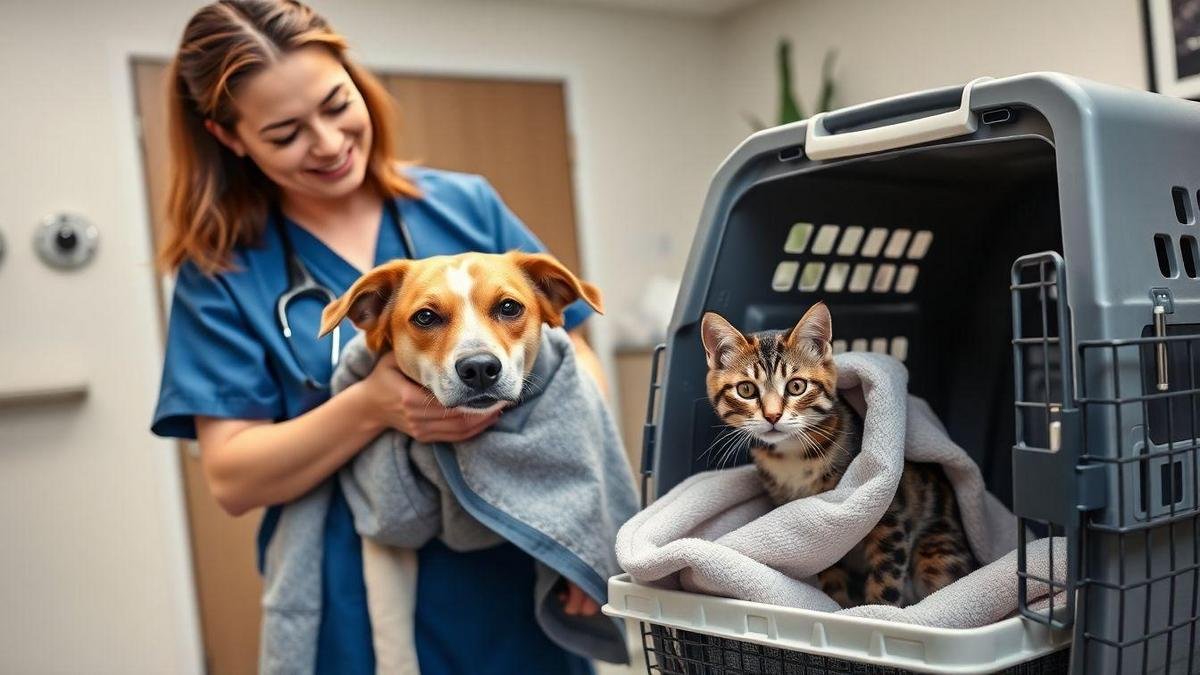
How I safely handle aggressive pets in clinic when I see Comportamento agressivo em gatos e cães durante visitas ao veterinário
I stay calm, move slowly, and treat the animal like a scared person. My aim is to keep everyone safe and reduce fear.
Low-stress handling methods
- Slow approach and let the pet sniff first.
- Use scent swapping (owner’s cloth) for comfort: scent enrichment tips.
- Minimal restraint; repeat short sessions instead of one long exam.
- Offer short breaks and stop before the pet hits its threshold.
| Method | Why | Signs I watch |
|---|---|---|
| Slow approach | Keeps pet calm | Relaxed ears/tail |
| Scent swapping | Gives comfort | Calmer breathing |
| Minimal restraint | Lowers stress | Less thrashing |
| Short breaks | Prevents escalation | Pet yawns or relaxes |
Example: a hissing cat calmed when I placed a towel with the owner’s scent and let her come out on her own.
When I use towels, muzzles, or trained restraint
I choose the least forceful option that ensures safety:
- Towel for nervous cats — covers claws and provides security.
- Muzzle for dogs that may bite — proper fit, allows breathing, short use only.
- Call a trained handler for trained restraint when necessary.
I always show and explain tools to the owner, use gentle hands, and monitor stress closely.
Clinic safety protocol
- Assess: Look for fear/aggression signs before touching.
- Plan: Choose low-stress methods; assign roles.
- Protect: Use towel/muzzle/handler only if needed.
- Communicate: Tell owner and team what will happen.
- Monitor: Watch breathing and posture during the exam.
- Debrief: Note behavior and what worked for next time.
| Step | Action |
|---|---|
| Assess | Look for signs before touching |
| Plan | Low-stress first, assign roles |
| Protect | Use tools only if needed |
| Communicate | Keep owner/team informed |
| Monitor | Watch behavior during exam |
| Debrief | Note progress and next steps |
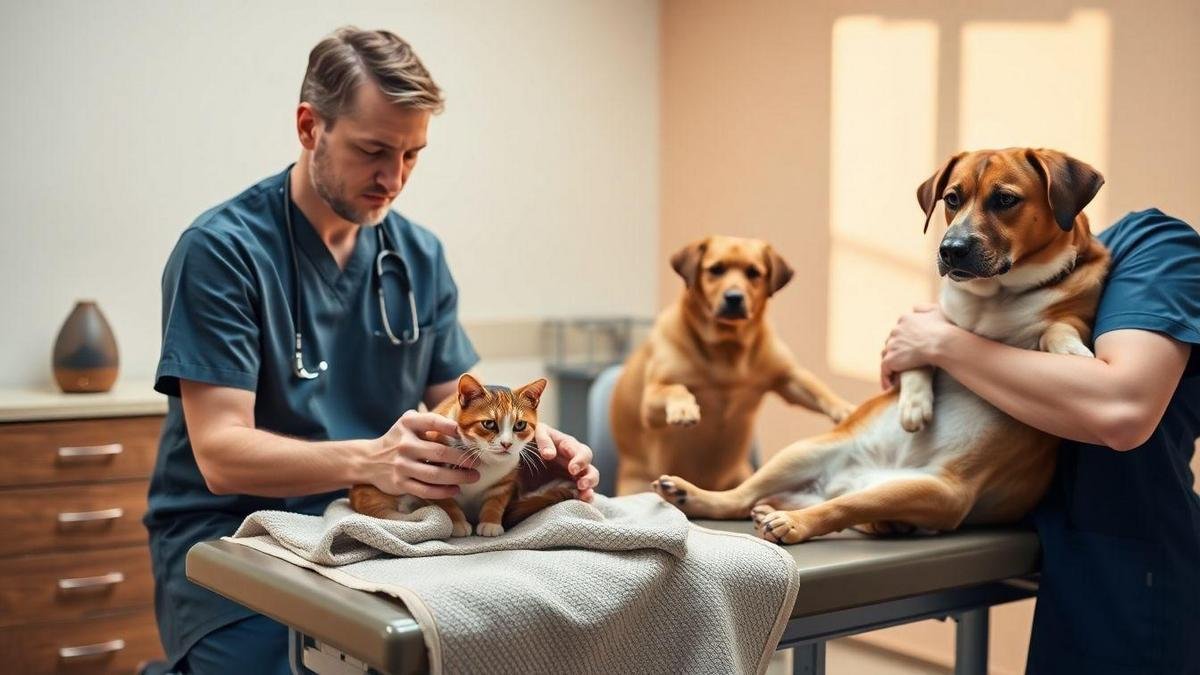
How I reduce pet stress and calm a pet at the vet to prevent Comportamento agressivo em gatos e cães durante visitas ao veterinário
I keep my approach calm, simple, and predictable. Lowering anxiety greatly reduces the chance of aggression.
Pre-visit routines
- Short, positive car rides (5–10 min) to desensitize the car: safe travel tips.
- Leave the carrier out at home with familiar bedding and treats; make the carrier part of a safe space as in ways to help pets feel safe at home.
- Visit the clinic parking lot briefly before entering, reward calm behavior.
| Action | What I do | Why it helps |
|---|---|---|
| Short car rides | 5–10 min drives | Makes car less vet-associated |
| Familiar bedding | Blanket in carrier | Smell reduces stress |
| Carrier practice | Leave open with treats | Carrier becomes safe spot |
| Quiet waiting | Ask for separate room | Fewer triggers |
Example: after a few calm car rides and her blanket, a cat slept through the exam.
In-clinic calming tools
- Pheromone wipes/sprays on the carrier or table — part of strategies to reduce pet stress indoors.
- High-value treats given only at the clinic.
- Request a quiet room or later appointment to avoid busy waiting rooms; think of the clinic as a place you can create a calm space, similar to tips for making quiet zones at home.
| Tool | How I use it | Benefit |
|---|---|---|
| Pheromones (Feliway/Adaptil) | Apply 10–15 min before visit | Cues safety |
| High-value treats | Small pieces during exam | Rewards calm |
| Quiet room | Separate space | Less noise and smells |
| Gentle handling | Slow touch and voice | Prevents escalation |
Short pre-visit routine to share with owners
- Two days before: leave the carrier out with blanket and treats.
- One day before: three short car rides (5–10 min).
- Morning of visit: put familiar bedding in carrier, bring a favorite toy.
- At arrival: ask staff for a quiet room or wait in the car.
- During exam: offer small treats, keep interactions brief.
- After: praise, calm walk or play.

How I use desensitization and training tips for Comportamento agressivo em gatos e cães durante visitas ao veterinário
Step-by-step desensitization
Start slow and short; always end on a positive note.
- Home: brief (3–10 sec) positive touches to ears, paws, muzzle — follow a simple daily routine like the daily touch-and-check routine. Reward immediately.
- Car: calm short sessions with bedding and treats.
- Clinic front: quick 3–10 min visits, treat and leave before stress.
- Exam room: 1–5 min brief exams, build up slowly.
| Stage | Location | Session length | Goal |
|---|---|---|---|
| 1 | Home | 3–10 sec touches | Comfort with handling |
| 2 | Car | 5–15 min | Calm during travel |
| 3 | Clinic front | 3–10 min | Comfort with clinic cues |
| 4 | Exam room | 1–5 min | Tolerate basic exam steps |
Watch body language and back up when you see stiff tails, pinned ears, growls, or wide eyes.
Reward-based training
- Use high-value treats, tiny pieces delivered fast.
- Use a consistent marker word (e.g., yes) or a clicker.
- Teach the pet the vet equals good things: reward when staff enter, sit, or touch calmly.
- Owners should move calmly and speak softly — pets pick up on human tension.
- When risk is high, use management tools (wraps, muzzles, veterinarian-advised sedation) to keep everyone safe while training continues.
Helpful related practices include teaching relaxation and settling skills such as settle-on-command exercises or short licking/feeding-based relaxation like using a lick mat.
| Reward type | Best for | Example |
|---|---|---|
| High-value treats | Strong fear | Cooked chicken, cheese |
| Toys | Play-driven dogs | Tug or short fetch |
| Calm petting | Some pets | Slow, gentle strokes |
| Scent rewards | Highly anxious | Owner-scented cloth (scent enrichment ideas) |
Simple daily exercises (3×5-min sessions)
| Exercise | Time | How |
|---|---|---|
| Touch & treat | 5 min | Touch paw/ears 3–5 sec, give treat |
| Car sit-ups | 5 min | Sit in car, treat, leave |
| Clinic walk-bys | 5 min | Walk near entrance, treat, leave early |
Small, consistent practice builds steady progress and mirrors many indoor stress-reduction techniques found in stress-reduction guides.
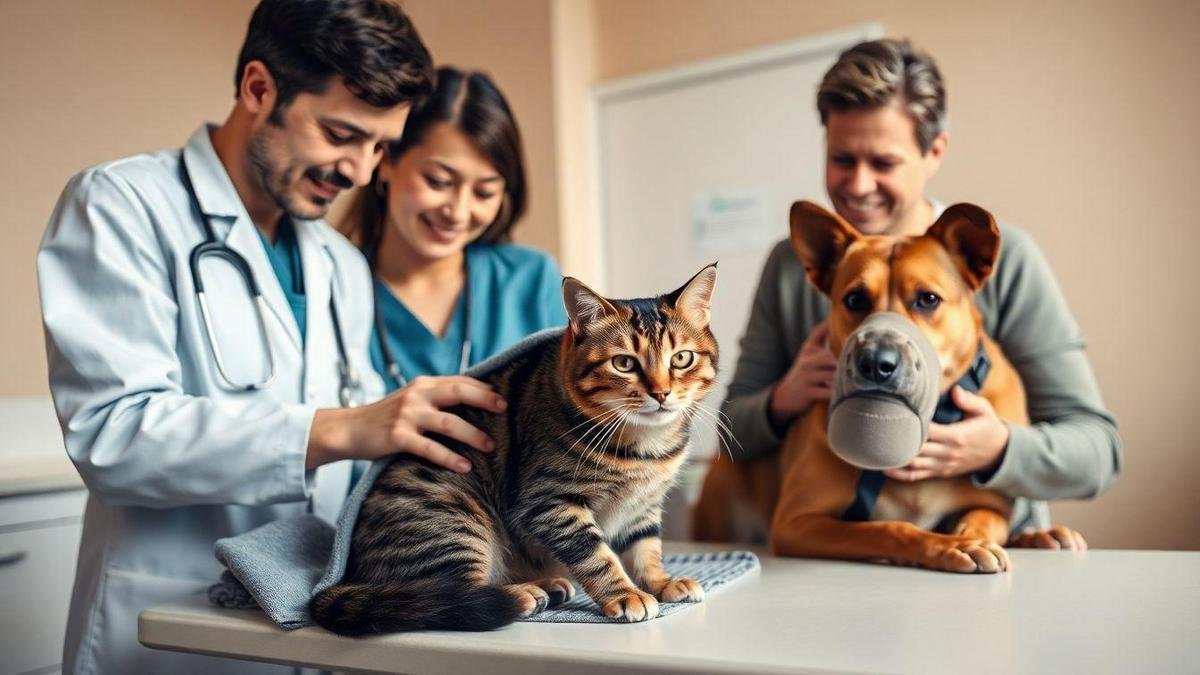
How I help prevent aggression during veterinary exams and keep everyone safe from Comportamento agressivo em gatos e cães durante visitas ao veterinário
I treat aggression as a fear or pain response, not malice. My steps reduce risk for staff, owners, and pets.
Appointment planning
- Book quiet times or separate wait times.
- Short appointments and quiet rooms reduce triggers.
- Ask owners about known triggers before arrival and request favorite bedding/toys.
| What I do | Why | How it helps |
|---|---|---|
| Separate wait times | Cut visual triggers | Less anxiety from other animals |
| Calm handling | Reduce sudden moves | Pets stay calmer |
| Pre-visit notes | Know fear signs | Plan the right approach |
| Quiet room | Lower noise/smells | Faster calming |
Policies I support
- Regular staff training on body language and low-stress handling — this builds consistency and trust similar to basic trust work for new pets: building consistent routines.
- Clear owner communication with pre-visit forms and simple prep steps.
- Trigger logs to note what set off a pet and which strategies worked.
| Policy | Action | Benefit |
|---|---|---|
| Training | Hands-on drills | Less reactive handling |
| Communication | Pre-visit forms | Owners arrive prepared |
| Trigger logs | Note behavior/solutions | Safer follow-ups |
Emergency plan if aggression occurs
- Stop the exam and give space.
- Call trained help.
- Use safe barriers or a towel to protect hands.
- Move the pet to a quiet area if possible.
- Treat injuries and document everything.
| Item | What to record |
|---|---|
| Who | Staff and owner present |
| What | Behavior, triggers, actions taken |
| When | Time and sequence |
| Outcome | Injuries, treatment, follow-up plan |
After an event, I file a report, review what worked, and discuss next steps with the owner (behavior help, alternate handling).
Conclusion
I see pets showing fear or pain, not malice. I always start by checking medical causes and then use low-stress handling, clear safety steps, and simple calming tools. Small signs — a stiff body, a hiss, a growl — cue me to slow down and change tactics.
My approach: treat the body first, then the behavior. Use towels, muzzles only when needed, pheromones, and short desensitization sessions paired with treats and praise. Favor rewards over punishment. Little wins — a half-second of calm — build trust one step at a time.
For more tips, routines, and real stories about preventing Comportamento agressivo em gatos e cães durante visitas ao veterinário, visit https://blogcraelo.com.
Frequently asked questions
Q: Why does my pet get aggressive at the vet?
A: Strange smells, unfamiliar handling, fear, and untreated pain commonly trigger aggression. This is often described as Comportamento agressivo em gatos e cães durante visitas ao veterinário.
Q: How can I calm my pet before a visit?
A: Use short car rides, leave the carrier out with familiar bedding, bring high-value treats and a favorite toy, and stay calm and quiet.
Q: Is aggression at the vet dangerous for my pet?
A: It can lead to injury or missed care. Work with your vet for a safe handling plan and rule out medical causes first.
Q: Can training fix vet-related aggression?
A: Yes—small, consistent desensitization and reward-based training often help. Start at home with brief handling sessions, then progress slowly.
Q: When should I get professional help or meds?
A: Seek a behaviorist or vet when aggression is severe, repeated, or risky. Medications may be considered when safety or progress is blocked and always under veterinary guidance.

